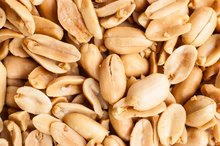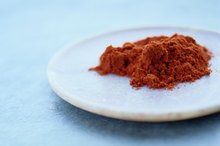What Are the Treatments for Chicken Pox in the Mouth?
Chicken pox is the common name for the disease that results from infection with the varicella-zoster virus. This condition causes a blistering skin rash that can affect the mucous membranes in the mouth.Treatments for chicken pox in the mouth focus on controlling the replication of the varicella-zoster virus, relieving discomfort and minimizing tissue damage.
Antiviral Drugs
Doctors typically prescribe antiviral drugs such as acyclovir, valacyclovir and famciclovir to treat chicken pox in adolescents and adults, as well as young children at high risk of complications. Given orally to most patients and intravenously to those with severe disease, antiviral drugs reduce the severity and duration of chicken pox lesions in all surfaces, including the mouth. Common side effects include nausea, vomiting, diarrhea and headache. In addition, doctors must proceed with caution in patients who have already taken one of the three drugs for another condition. Since the drugs target the same step in viral replication, resistance to one usually means resistance to all.
- Doctors typically prescribe antiviral drugs such as acyclovir, valacyclovir and famciclovir to treat chicken pox in adolescents and adults, as well as young children at high risk of complications.
- Given orally to most patients and intravenously to those with severe disease, antiviral drugs reduce the severity and duration of chicken pox lesions in all surfaces, including the mouth.
Local Anesthetics
What Are the Treatments for Chickenpox on the Scalp?
Learn More
Chicken pox in the mouth often cause pain and itching out of proportion to symptoms elsewhere on the body, due to the dense supply of sensory nerves within the mouth. Frequent application of over-the-counter local anesthetic drugs can help, according to a study published in 2009 edition by “Clinical and Experimental Dermatology.” Local anesthetics block the transmission of pain and itch signals from the sensory nerves 3. While doctors normally inject local anesthetic drugs, the mucous membranes of the mouth are thinner than skin, so drugs such as benzocaine can achieve limited penetration through topical application. In addition, the drugs come in a gel or paste vehicle that provides a thin protective coating that helps -- at least temporarily -- shield the ulcer from other contents of the mouth.
- Chicken pox in the mouth often cause pain and itching out of proportion to symptoms elsewhere on the body, due to the dense supply of sensory nerves within the mouth.
- While doctors normally inject local anesthetic drugs, the mucous membranes of the mouth are thinner than skin, so drugs such as benzocaine can achieve limited penetration through topical application.
Supportive Care
Patients with sores in the mouth steer clear of chemical irritants such as spicy foods, citrus and other acids, as well as physical irritants such as hot foods, nuts and potato chips. Since the presence of chicken pox lesions in the mouth often signals disruption of taste sensation to the front two-thirds of the tongue, people with chicken pox may need to rely on friends and associates to identify these ingredients for them. In addition, patients should practice basic hygiene to prevent chicken pox lesions in the mouth from becoming secondarily infected by bacteria. Tooth brushing at least twice a day, flossing and using disinfectant mouthwash are sufficient for most people; however, patients should take care not to apply toothpaste directly to the lesions, because the abrasives in toothpaste can cause mechanical irritation and tissue trauma.
- Patients with sores in the mouth steer clear of chemical irritants such as spicy foods, citrus and other acids, as well as physical irritants such as hot foods, nuts and potato chips.
- Tooth brushing at least twice a day, flossing and using disinfectant mouthwash are sufficient for most people; however, patients should take care not to apply toothpaste directly to the lesions, because the abrasives in toothpaste can cause mechanical irritation and tissue trauma.
Related Articles
References
- "Harrison's Principles of Internal Medicine, 23rd Edition;" A.S. Fauci et al.; 2008
- "Fitzpatrick's Dermatology in General Medicine, 7th Edition;" K. Wolff et al.; 2008
- “Clinical and Experimental Dermatology;” Oral Ulcers: Clinical Aspects; M. Munoz-Corcuera et al.; Apr. 2009
- MedlinePlus: Mouth Ulcers
- KidsHealth.org: Mouth and Teeth: Canker Sores
Writer Bio
Heather Gloria began writing professionally in 1990. Her work has appeared in several professional and peer-reviewed publications including "Nutrition in Clinical Practice." Gloria earned both a Bachelor of Science in food science and human nutrition from the University of Illinois. She also maintains the "registered dietitian" credential and her professional interests include therapeutic nutrition, preventive medicine and women's health.









